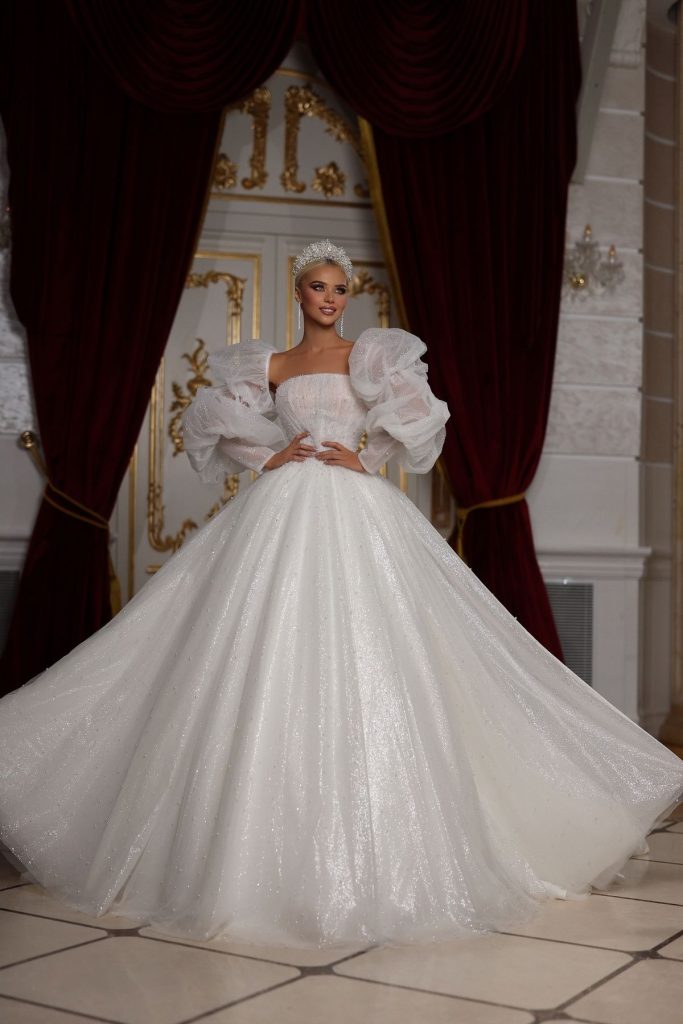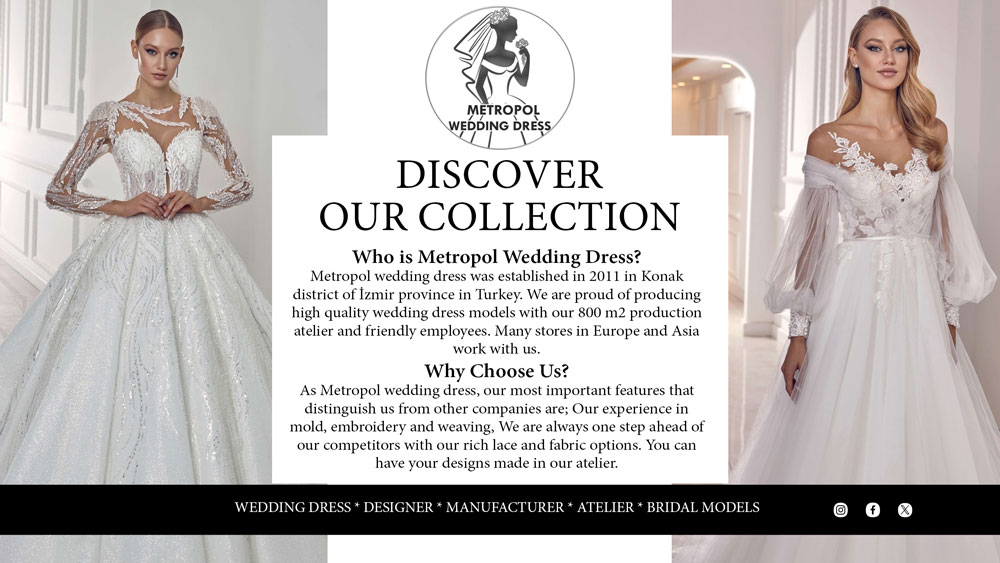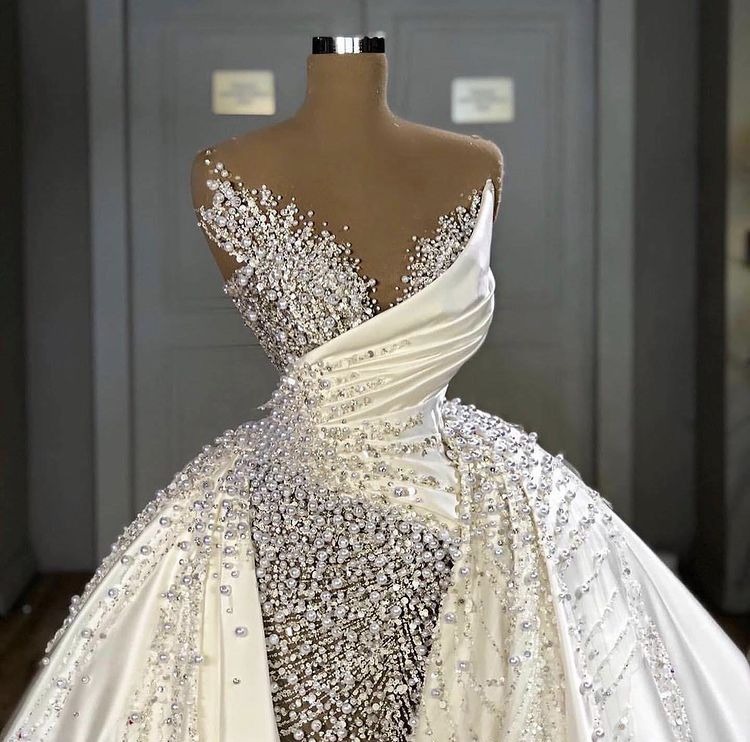
Designer Bridal Gown Shop Bridal gowns have come a long way since the iconic white wedding dress popularized by Queen Victoria in 1840. Today, in a designer bridal gown shop, you’ll find a fusion of heritage craftsmanship and forward-thinking designs that cater to diverse tastes. The year 2025 marks a pivotal shift towards maximalism and personalization, where brides seek pieces that not only flatter their figure but also tell their unique love story.
Key Trends Shaping 2025 Bridal Gowns
Drawing from the latest runway shows and expert insights, here are the standout trends dominating designer bridal gown shops this year:
- Basque Waists for Regal Silhouettes: Inspired by 18th-century opulence, basque waists dip into a V or U shape, cinching the midsection for an hourglass effect. Perfect for ballgowns and A-lines, this trend adds vintage romance without sacrificing comfort. Designers like Nicole + Felicia (NF043) and Martina Liana (1860) are leading the charge, with gowns that evoke royal grandeur. Brides love how it accentuates curves while allowing fluid movement down the aisle.
- Brocade Fabrics for Textural Luxury: Move over plain satin—brocade’s intricate, woven patterns bring depth and sophistication to any gown. This rich fabric pairs seamlessly with modern cuts, offering a subtle shimmer that’s ideal for evening receptions. Look for pieces from Justin Alexander’s Josette line or Soterro & Midgley’s Aberdeen collection in your local designer bridal gown shop. It’s a trend that’s both timeless and on-point for 2025’s bold aesthetic.
- Square Necklines: Clean and Contemporary: For a fresh take on classic necklines, square cuts provide a structured, flattering frame that highlights the décolletage. Versatile enough for sleek satins or embroidered lace, this style suits multiple body types. All Who Wander’s Byron gown and Disney Fairy Tale Weddings’ D413 are prime examples, available at forward-thinking designer bridal gown shops.
- Pearl Accents: Subtle Glamour Redefined: Pearls aren’t just for heirlooms anymore—they’re scattered like stardust across bodices and trains for an ethereal glow. Madison James’ MJ1062 and Allure Couture’s C740 embody this trend, adding layers of texture without overwhelming the design. In 2025, expect to see them in every designer bridal gown shop as the go-to for understated elegance.
- Strategic Slits for Movement and Edge: Who says bridal has to be demure? Thigh-high or subtle side slits inject drama and practicality, letting you dance the night away while showcasing statement shoes. Lillian West’s 66331 and Martina Liana’s ML1841 are must-tries for the bold bride visiting a designer bridal gown shop.
- Long Sleeves with Modern Twists: Balancing coverage and allure, long sleeves in sheer lace or embroidered fabrics offer modesty with a sexy edge. Justin Alexander’s Dabira and Maggie Sottero’s Torrence gowns are highlights, ideal for destination weddings or cooler climates.
- High Necklines for Sophisticated Poise: High collars frame the face beautifully, elongating the neck and allowing arm-baring drama below. Kathryn Elizabeth’s Allegra and Nicole + Felicia’s NF088 showcase this refined look, a staple in premium designer bridal gown shops.
- Matte Lace for Organic Romance: Ditching glossy finishes, matte lace provides a soft, natural vibe that’s lightweight and breathable. Justin Alexander’s Joelle and Allure’s A1304 capture this trend perfectly, making it a favorite for bohemian-inspired brides.
These trends, as seen in New York Bridal Fashion Week, emphasize personalization—think bubble skirts and offbeat bows for a playful twist. When scouting a designer bridal gown shop, ask stylists about how these elements can be customized to your vision.
Historical Context: How Trends Evolve
To appreciate 2025’s innovations, consider the journey. The 1920s flapper era brought beaded fringe, while the 1950s Dior New Look introduced full skirts. Today, sustainability influences trends, with eco-friendly brocades and recycled pearls gaining traction in ethical designer bridal gown shops. This evolution ensures your gown isn’t just beautiful—it’s meaningful.
Top Designers to Seek in a Designer Bridal Gown Shop
No visit to a designer bridal gown shop is complete without exploring iconic labels. Based on 2025 rankings, here are standout designers whose collections are gracing the racks.
The 13 Best Brands for 2025, According to Experts
From ELLE’s curated list, these brands offer everything from affordable chic to haute couture:
- Vivienne Westwood: Neoclassical corsetry meets draping drama. Signature: The Galaxy dress. Shop at viviennewestwood.com/bridal-boutique.
- Reformation: Re-wearable modern slips and suits. Signature: Silk-satin with cowl necks. Available at thereformation.com/bridal.
- De La Vali: Bohemian versatility with backless minis and lace gowns. Shop via harveynichols.com.
- Halfpenny London: Bespoke elegance starting at £600. Flagship in Bloomsbury.
- Rixo: Vintage-inspired under £1500. Stores in Chelsea and Marylebone.
- Whistles: High-street luxury under £1000. Try-ons at St Christopher’s Place.
- Shona Joy: Slip dresses to full skirts, from £100. Revolve.com exclusive.
- Elliatt: Affordable Aussie florals from £225. Shop at revolve.com.
- Clio Peppiatt: Embellished pearls and crystals. Custom in West London.
27 Iconic Designers for the Discerning Bride
Expanding further, Lookslikefilm highlights 27 powerhouses:
- Vera Wang: Modern elegance with innovative silhouettes. verawang.com
- Oscar de la Renta: Luxurious lace and embroidery. oscardelarenta.com
Navigating the Best Designer Bridal Gown Shops in the USA for 2025
Finding the right designer bridal gown shop is as crucial as the gown itself. These boutiques provide personalized service, exclusive previews, and alteration expertise. Based on 2025 recommendations, here are top picks across the U.S.
East Coast Gems: New York and Boston
- The Bridal Collection (NYC): Home to trends like basque waists. Book appointments for expert styling. Detailed review: Spacious showroom, diverse inventory from Martina Liana to Allure.
- L’Elite Bridal (Boston): Trunk shows from Ines DiSanto. Custom fittings for dream dresses.
West Coast Wonders: LA and San Francisco
- KYHA Studios (NY, but West Coast expansions): Modern takes on tradition. kyhastudios.com.
- Allure Bridals (Various locations): Timeless to modern styles. allurebridals.com.
Midwest and South Highlights
- David’s Bridal (Nationwide): New 2025 arrivals with trends. davidsbridal.com.
- Maggie Sottero Boutiques: Light-inspired Fall 2025. maggiesottero.com.
How to Choose Your Perfect Gown in a Designer Bridal Gown Shop
Shopping smart elevates the experience. Start with a mood board of 2025 trends, then schedule appointments at 3-5 designer bridal gown shops. Budget wisely: Expect $2000-$10,000 for designer pieces.
Step-by-Step Buying Guide
- Research Designers: Use lists above to narrow options.
- Appointment Prep: Bring photos, know your style (e.g., A-line for pear shapes).
- Try-On Session: Focus on fit, fabric feel, and movement.
- Alterations and Timeline: Order 6-9 months ahead.
- Sustainability Check: Ask about ethical sourcing.
Caring for Your Designer Bridal Gown Post-Purchase
Once home, preserve your treasure. Dry clean only, store in acid-free boxes, and avoid sunlight. For heirloom potential, consult shop experts.
Real Bride Stories: Transformations in Designer Bridal Gown Shops
Conclusion: Your Dream Awaits in a Designer Bridal Gown Shop
In 2025, a designer bridal gown shop isn’t just a store—it’s a portal to your forever. Embrace the trends, trust the designers, and let your style shine. Ready to start? Book that appointment today.
1. The Timeless Appeal of Bridal Dresses
Bridal dresses are the cornerstone of wedding fashion, embodying romance, tradition, and personal style. In 2025, these gowns are evolving with trends that blend heritage with innovation, offering brides endless possibilities to express their individuality.
Why Bridal Dresses Remain Iconic
Top Trends in Bridal Dresses for 2025
2. Allure Wedding Dresses: Romantic Elegance Redefined
Signature Features of Allure Wedding Dresses
- Diverse Collections: From Bridgerton-inspired opulence to minimalist Madison James designs, Allure caters to every bride.
Where to Find Allure Wedding Dresses
3. SSENSE Bridal: Avant-Garde Meets Bridal Chic
SSENSE Bridal brings a fashion-forward edge to wedding attire, offering curated selections from high-end designers. Known for its bold aesthetic, SSENSE is the go-to for brides seeking non-traditional luxury wedding dresses.
Why SSENSE Bridal Stands Out
- Unique Silhouettes: From slip dresses to structured corsets, SSENSE prioritizes individuality.
- Global Accessibility: Shop online at ssense.com for worldwide shipping.
Styling SSENSE Bridal Gowns
Pair with minimalist accessories to let the gown shine. A sleek veil or pearl headpiece complements their avant-garde vibe.
4. Luxury Wedding Dresses: Opulence for the Modern Bride
Luxury wedding dresses are the epitome of grandeur, crafted with premium materials and intricate details. In 2025, these gowns are about making a statement, whether through hand-stitched beadwork or cathedral trains.
Defining Features of Luxury Wedding Dresses
Top Designers for Luxury Wedding Dresses
5. NYD Dress: New York’s Bridal Fashion Hub
6. Mermaid Evening Dress: Glamour for Special Occasions
Key Features of Mermaid Evening Dresses
Where to Shop
7. Mermaid Dress for Women Wedding: The Ultimate Bridal Statement
Why Choose a Mermaid Wedding Dress?
Styling Tips
8. Mermaid Dress for 5 Years Girl: Adorable Elegance
The mermaid dress for 5 years girl brings whimsy to flower girl attire, mimicking the bride’s style in miniature form. These dresses are designed for comfort and charm, ensuring little ones shine.
Features of Mermaid Dresses for Young Girls
- Mini Fishtails: Subtle flares keep the look playful.
- Embellishments: Small bows or floral details add sweetness.
Where to Shop
9. Mermaid Dress for Girls: Playful Yet Elegant
The mermaid dress for girls extends the mermaid trend to young wedding party members, offering a balance of fun and formality.
Design Highlights
- Color Options: Soft pastels or white to match the bridal theme.
- Customizable: Add detachable sashes for personalization.
10. Mermaid Style Gown with Fishtail: The Classic Silhouette
Why It’s a Favorite
Top Picks for 2025
11. Mermaid Style Dress for Little Girl: Fairy-Tale Charm
The mermaid style dress for little girl brings enchantment to young attendants, with scaled-down fishtails that ensure comfort and style.
Key Elements
- Breathable Fabrics: Cotton blends and tulle for all-day wear.
- Subtle Flares: Less dramatic than adult gowns for ease of movement.
- Fun Details: Glitter mesh or small sequins for sparkle.
12. Mermaid Gown Dress: A Timeless Choice
Why It Works for All

13. Shopping Smart at a Designer Bridal Gown Shop
Finding the perfect gown starts with choosing the right designer bridal gown shop. Here’s how to navigate the process:
Tips for a Successful Shopping Experience
Top Shops to Visit
14. Caring for Your Bridal and Mermaid Gowns
Post-purchase care ensures your bridal dresses or mermaid gown dresses remain pristine. Use acid-free storage boxes, avoid sunlight, and opt for professional dry cleaning.
15. Real Bride and Party Stories
Conclusion: Your Dream Dress Awaits
Whether you’re drawn to the timeless charm of bridal dresses, the bold elegance of Allure wedding dresses, or the whimsical mermaid style dress for little girl, 2025 offers a gown for every vision. Visit a designer bridal gown shop, explore SSENSE bridal, or browse NYD dress boutiques to find your perfect match. Let your wedding day shine with a dress that’s uniquely you.
Weddings are more than just ceremonies; they are vibrant tapestries woven from culture, emotion, and celebration. In Turkey, where East meets West in a symphony of ancient rituals and modern flair, weddings stand out as grand spectacles that blend heartfelt traditions with opulent style. Whether you’re a bride-to-be dreaming of a henna night under the stars or a guest curious about the red veil’s allure, understanding Turkish wedding customs opens a door to a world of joy, symbolism, and unforgettable moments.
Why Do Turkish Brides Wear a Red Veil?
The sight of a bride veiled in crimson is one of the most striking images in Turkish wedding lore. But what lies behind this bold choice? The red veil, known as “kırmızı duvak” in Turkish, is far more than a fashion statement—it’s a profound symbol rooted in centuries-old beliefs, protection rituals, and cultural vitality.
The Symbolism of Red in Turkish Culture
In Turkish tradition, red represents life, vitality, happiness, and infinity. Drawing from ancient Turkic roots, the color evokes the earth’s life-giving energy and the sun’s eternal warmth. Brides wearing red are believed to embody these forces, inviting prosperity and joy into their new life. This isn’t unique to weddings; red appears in Turkish folklore, from evil eye amulets to festive attire, underscoring its role as a guardian against misfortune.
Historically, the red veil served as a protective shield. Folklore whispers that it wards off the “nazar,” or evil eye—a malevolent gaze that could curse the bride’s future happiness. By draping her face in red during the procession to the groom’s home, the bride is safeguarded from envious onlookers. This practice echoes Ottoman-era customs, where vibrant colors were thought to confuse malevolent spirits.
Evolution from Tradition to Modern Twists
While traditional red veils were often simple silk or muslin scarves, today’s brides blend heritage with haute couture. Imagine a delicate red chiffon overlay on a white lace gown, or a veiled entrance at a seaside ceremony in Bodrum. In rural Anatolia, the veil might still be a full covering, symbolizing modesty and the bittersweet farewell to maidenhood. Urban brides in Istanbul, however, opt for subtle accents—like a red ribbon woven into the veil or embroidered motifs of pomegranates, fertility symbols.
The red ribbon around the bride’s waist, tied by her father, complements the veil. This “bekâret kemeri” (maidenhood belt) signifies purity and invites wealth; its absence once sparked village gossip, but now it’s a personal choice. During the “gelin alma” (bride-taking) procession, guests shower the veiled bride with rice and sweets, amplifying the veil’s protective aura.
Personal Stories and Cultural Impact
Consider Ayla, a bride from Izmir who shared her story: “My grandmother insisted on the red veil—it felt like wrapping myself in family history. As I walked to the car, the color made me feel invincible.” Such anecdotes highlight the veil’s emotional weight, bridging generations.
In a globalized world, the red veil influences diaspora weddings. Turkish communities in Germany or the U.S. incorporate it into fusion ceremonies, pairing it with Western tiaras. Designers like Elbise Atölyesi in Ankara now craft bespoke red veils with Swarovski crystals, costing 500-2000 TRY ($15-60 USD), making tradition accessible and luxurious.
Tips for Incorporating the Red Veil
- For Destination Brides: Pair a lightweight red veil with a bohemian gown for Cappadocia’s fairy chimneys backdrop.
- DIY Option: Use sheer red organza and gold threads for a budget-friendly homage.
- Photographic Magic: Time your reveal for golden hour—the contrast of red against sunset hues is Instagram gold.
How Many Days Is a Turkish Wedding?
Turkish weddings are marathons of merriment, not sprints. Unlike the one-day affairs common in the West, traditional celebrations can span multiple days, each layer unfolding like a richly embroidered kilim rug. But how many days exactly? It depends on region, family size, and whether you’re in a bustling city or a sleepy village.
The Traditional Multi-Day Timeline
Historically, Turkish weddings lasted 40 days and 40 nights—a nod to epic tales like those in the Epic of Manas. In rural areas today, they condense to three days: the henna night (kına gecesi), engagement echoes, and the main feast. Day one might kick off with the bride’s farewell party, where female relatives gather for tears, toasts, and henna application. Day two features the groom’s procession, flag-planting at his home, and neighborhood parades. The climax? Day three’s civil ceremony and reception, often under a canopy of fairy lights.
In small towns like those in the Black Sea region, expect a three-night whirlwind. The first night honors the bride with songs and sweets; the second, the groom with mock battles and dances; the third seals vows with fireworks and feijoa feasts. Urban weddings in Ankara or Izmir slim down to one or two days, blending civil rites with evening galas.
Regional Variations and Modern Adaptations
Coastal spots like Antalya host beachside marathons: a sunset henna on day one, yacht vows on day two, and poolside afterparties on day three. Inland, in conservative Konya, multi-day events emphasize religious elements, with separate gender-segregated gatherings extending the timeline.
For expats or destination couples, planners like those in Fethiye offer customizable packages. A “quickie” wedding? One day, from paperwork to party. The full immersion? Three days, incorporating olive branch blessings and equestrian arrivals. Post-COVID, hybrid formats emerged—virtual henna streams for overseas kin, shortening physical days but lengthening emotional ones.
Logistics and What to Expect Each Day
- Day 1: Pre-Wedding Rituals – Henna application, where the bride’s hands are adorned with intricate designs symbolizing fate. Expect emotional laments (ağlama) and belly dancing.
- Day 2: Processions and Parties – The groom’s friends “raid” the bride’s home playfully, negotiating entry with gold coins.
- Day 3: The Ceremony – Civil signing, ring exchange, and a zeybek dance finale.
Costs escalate with duration; a three-day rural bash might hit 100,000 TRY ($3000 USD), covering catering for 500. Pro tip: Pace yourself—Turkish coffee fuels the festivities.
Why the Length Matters
Are Weddings in Turkey Cheap?
Ah, the million-lira question: Are Turkish weddings a budget bride’s dream or a lavish liability? The answer? It depends. Turkey’s wedding scene offers everything from rustic village feasts under 10,000 TRY ($300 USD) to Istanbul extravaganzas topping 500,000 TRY ($15,000 USD). Compared to Western counterparts—where U.S. averages hover at $30,000 USD—Turkey shines as affordable, especially for destinations.
Breaking Down the Costs
On average, a Turkish wedding clocks in at 450,000 TRY ($13,700 USD) for 2024, up from pre-inflation days due to economic flux. Venue: 50,000-150,000 TRY ($1500-4500) for a seaside hall. Catering: 100-200 TRY ($3-6) per head for meze, kebabs, and baklava—feed 400 for under 80,000 TRY.
Bridal gown? 5,000-20,000 TRY ($150-600), with rentals at half price. Photography and DJ: 10,000-30,000 TRY ($300-900). Destination add-ons like legal fees for foreigners? Another 5,000 TRY.
| Category | Budget Option (TRY) | Mid-Range (TRY) | Luxury (TRY) |
|---|---|---|---|
| Venue | 10,000 | 50,000 | 150,000 |
| Catering | 20,000 (100 guests) | 80,000 (400) | 200,000 |
| Dress | 3,000 (rental) | 10,000 | 50,000 |
| Total | 50,000 | 200,000 | 500,000+ |
Why Turkey Feels Like a Steal
Low labor costs and seasonal venues keep prices down. A UK bride saved 70% hosting in Antalya versus London, citing “endless beaches for free backdrops.” Inflation bites, but gold gifts from guests offset expenses—brides often walk away with 50,000 TRY in jewelry.
For internationals, packages start at 2,899 EUR ($3100 USD) including planner and ceremony. Hidden fees? Currency fluctuations and peak-season surcharges (June-October).
Budget Hacks and Pitfalls
- Hack: Opt for off-season (November-March) for 30% discounts.
- Pitfall: Over-inviting—Turkish hospitality means 500+ guests, ballooning costs.
- Eco-Tip: Vineyard weddings in Urla combine affordability with sustainability.
In short, yes—Turkish weddings can be cheap(ish), offering opulence without bankruptcy. It’s the perfect blend of value and vibrancy. (Cumulative: ~1750)
Who Should Pay for the Bride’s Dress?
Tradition whispers, modernity shouts, but in Turkish weddings, the bride’s dress often falls to a shared ledger. Historically, the groom’s family foots the bill for the wedding writ large, including her gown—a gesture of commitment and provision. Yet, nuances abound.
Traditional Payment Dynamics
In conservative families, the groom’s side covers the bride’s attire as part of the “dowry reversal.” Once, families exchanged goods; now, it’s cash for couture. A 10,000 TRY gown? Groom pays, signaling his readiness to build a home. The bride’s family handles henna night and invitations.
Urban shifts see couples splitting: Bride buys her dress, groom his suit. “It’s empowering,” says Istanbul designer Leyla Kaya. Gold from engagement (nişan) often funds it—guests pin coins to the couple’s sashes.
Cultural and Legal Angles
Islamic influences suggest the groom provides mahr (bridal gift), which could include the dress. Legally, no mandates; it’s familial negotiation. In diaspora, Western norms creep in—brides paying via bridal showers.
| Payer | Traditional Role | Modern Twist |
|---|---|---|
| Groom’s Family | Full coverage | Partial (50%) |
| Bride’s Family | Accessories | Full in progressive homes |
| Couple | N/A | Joint via savings |
Advice for Harmony
Discuss early—avoid “who pays” drama. Budget: 5-15% of total wedding. Ultimately, it’s about unity; the dress is just fabric, the gesture eternal. (Cumulative: ~2100)
What Are Turkish Wedding Traditions?
Turkish weddings are a kaleidoscope of rituals, from henna-stained hands to flag-waving processions. These customs, blending Byzantine, Ottoman, and nomadic Turkic elements, create a sensory feast of music, food, and emotion.
Pre-Wedding Rituals: Building Anticipation
The journey starts with “söz kesme” (promise ceremony), where families exchange sweets and rings over tea. Then, nişan: A party with mock fights and toasts, rings on separate fingers until vows.
Henna night is poetic—women in red bindallı gowns gather; the bride’s palms receive henna, her tears flow to “soften” her future mother-in-law’s heart. Songs like “Kına Yaktı” echo bittersweet farewells.
The Wedding Day: Vows and Vigils
Groom’s friends plant a flag at his home, announcing the union. The bride’s exit involves stepping on the groom’s foot for dominance—a playful power play.
Civil ceremony first (mandatory), then religious if desired. Guests shower couples with grains for fertility. The “para takma” (money pinning) sees bills and gold clipped to gowns amid dances.
Post-Wedding and Superstitions
Newlyweds break plates for luck; mirrors reflect futures. Avoid black cats or salt spills—nazar boncuk beads guard against.
- Food Traditions: Pilav and sheep sacrifice for abundance.
- Dances: Zeybek for men, horon in the north.
- Gifts: Gold sets from guests.
Modern fusions include drone footage of processions. These traditions aren’t relics; they’re living threads in Turkey’s cultural fabric, ensuring every wedding tells a story of heritage and hope. (Cumulative: ~2800)
What Is the Most Popular Wedding Dress Today?
In 2025, the wedding dress landscape pulses with romance and rebellion. The undisputed queen? The A-line silhouette—flattering, forgiving, and eternally chic. Its fitted bodice flares to a full skirt, suiting all body types and venues.
Timeless Trends Resurging
A-line dominates, but mermaids trail closely for hourglass drama. 2026 forecasts basque waists (dipped V at hips) and cat-eye necklines for vintage allure.
Short dresses—midi or mini—surged post-pandemic, ideal for dance floors. Corsetry and bows add whimsy; think detachable overskirts for versatility.
Fabrics? Satin sheens and lace appliqués rule, with eco-silks rising.
Global Influences and Turkish Twists
In Turkey, A-lines pair with red accents. Popular styles: Off-shoulder for beaches, square necks for elegance.
| Style | Why Popular | Price Range (USD) |
|---|---|---|
| A-Line | Versatile | 500-3000 |
| Mermaid | Sexy curve | 800-5000 |
| Short | Modern fun | 400-2000 |
Shopping Savvy
Hunt at Kleinfeld or local ateliers. Sustainability? Rent or upcycle. The A-line isn’t just popular—it’s a canvas for your love story. (Cumulative: ~3200)
Which Is More Expensive, Tulle or Chiffon?
Fabric choices can make or break a budget—enter tulle versus chiffon, bridal darlings with distinct vibes and price tags. Spoiler: Chiffon edges out as pricier, but let’s dissect why.
Fabric Fundamentals
Tulle: A stiff, netted mesh for volume—think ballerina skirts. At $2-5/yard, it’s economical for layers.
Chiffon: Sheer, silky weave from silk or polyester, draping like liquid. $4-10/yard, its finesse demands premium sourcing.
Cost Factors and Comparisons
Labor: Chiffon’s slipperiness hikes sewing time, adding 20-30% to gown costs. Tulle? Quick and stackable.
Quality tiers: Silk chiffon soars to $20/yard; synthetic tulle stays low.
In dresses: A chiffon A-line? $1500+. Tulle ballgown? $1000.
| Fabric | Yard Cost (USD) | Dress Impact | Best For |
|---|---|---|---|
| Tulle | 2-5 | Volume boost | Poufy skirts |
| Chiffon | 4-10 | Elegant flow | Flowy overlays |
Verdict and Tips
Chiffon wins (slightly) on expense due to luxury appeal. Mix them: Chiffon bodice, tulle skirt for balance. For budgets, tulle’s your thrift ally. (Cumulative: ~3500)
Who Wears the Most Expensive Wedding Dress?
Extravagance knows no bounds in bridal couture. The crown for costliest gown? Angelababy’s 2015 Dior masterpiece at $31 million, encrusted with 5,000 diamonds for her union with Huang Xiaoming.
Record-Breakers Ranked
- Angelababy: $31M – Swarovski splendor.
- Serena Williams: $3.5M – Vera Wang with 115-carat diamond.
- Queen Elizabeth II: $1.6M (adjusted) – Norman Hartnell embroidery.
Princess Diana’s $800K icon? Iconic, but outshone by modern opulence. Royals like Charlene of Monaco ($100K Armani) add grace.
| Bride | Dress Cost (USD) | Designer | Standout Feature |
|---|---|---|---|
| Angelababy | 31M | Dior | Diamond cascade |
| Serena | 3.5M | Vera Wang | Pearl embroidery |
| Diana | 800K | Emanuel | 25ft train |
What Drives the Price?
Swarovski, rare lace, custom hours. Celebrities amplify via auctions—Diana’s fetched millions post-wedding.
Inspiration for All
Even if not $31M, emulate with heirloom pearls. These gowns aren’t just dresses; they’re legacies of love’s lavish side. (Cumulative: ~3800)
Conclusion: Crafting Your Turkish Dream Wedding
From the protective red veil to multi-day revelries, Turkish weddings weave tradition with today’s trends. Affordable yet lavish, they invite personalization—whether splitting dress costs or choosing chiffon over tulle. As you plan, remember: The true expense is in memories, the real veil, one of joy.







